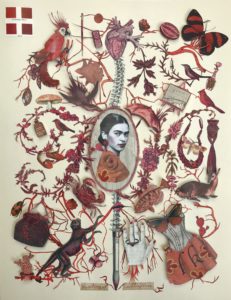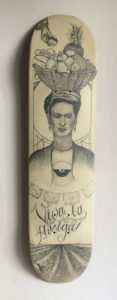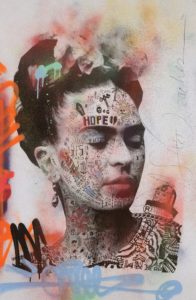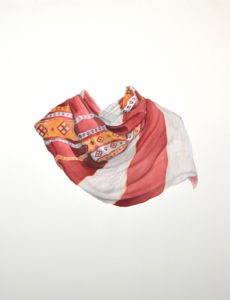
Meet the artists featured in the exhibition, The World of Frida, organized by the Bedford Gallery in Walnut Creek, CA. Every other week we will highlight a few of the artists included in the exhibition. The 95 international artists featured in The World of Frida have reinterpreted many aspects of Frida Kahlo’s life in an array of media — from honoring her self-portraits, to depicting her love affair with Diego Rivera, to recognizing her emotional, physical, professional and societal struggles. This exhibition is an incredible tribute to an artist who continues to influence millions by the simple fact that she was always true to herself, no matter the cost.
Barbara Johansen Newman
Needham, MA

Barbara Johansen Newman, All this Madness, 2018, acrylic on wood, 43 x 37 x 5 in.
Artist Statement
Regardless of the venue or medium, my goal over many years of making art has essentially been the same: to explore the essence of a portrait.
For me, a portrait is one part of a far more complex story. I have always been preoccupied with the passage of time, and that comes into play when I weave relics of the past into the design, texture and color of my pieces by playing with surfaces and combining unlikely materials. I sometimes use found objects, architectural salvage, furniture remnants, and other scraps derived from past uses and former lives. Or, I will refer to those kinds of items in my paintings. I like to play with the illusion of texture in my mark making, not unlike the way I used surface decoration during my career as a fiber artist. With this multi faceted approach, I seek to capture a fragment of a tale that is, or was, or has the promise to become. If I’ve done my job, the viewer will have enough visual clues to unravel the implied narrative.
Katie McCann
Berkeley, CA

Katie McCann, Frida’s Red, 2018, collage, 15 x 12 in.
Artist Statement
With just a pair of scissors, I create intricate, hand cut collages which reflect my Victorian obsession with faeries, flora and fauna. From my large collection of books, prints and pages that are antique, forgotten and foxed with age, I cut out images, categorize them and then eventually piece them together like a complex paper jigsaw. My collages are places where beauty is strange, creatures are curious and a sense of wonder prevails.
The female face is central to much of my artwork and often acts as a reflection of the natural and sometimes magical world. She can be surrounded by birds, fish and butterflies or submerged in a dense wallpaper pattern which either represents her prison or her liberation.
I have recently found that my collages are becoming more orderly and methodical – neatly arranged, strange objects fill the page like rows of paper microscope slides or specimens in a tiny cabinet of curiosity. My need to obsessively cut can sometimes outweigh the composition of the piece, so I am often left with piles of abandoned cuttings – lost bones, moths, fungi, feathers, coral, shells and butterfly wings. Eventually these too will find a place to reside.
Jazmine Parra

Jazmine Parra, Viva La Huelga, 2018, graphite on skateboard deck, 31 x 8 in.
Jazmine Parra grew up in California’s Central Valley where a large Latino population works the field, picking and pulling agriculture for the United States. Parra chose to use an image of Frida Kahlo – an image synonymous with strength and endurance to represent Latino farm workers of America. Kahlo is depicted with a fruit basket atop her head and the words “Viva La Huelga” is written in script below Kahlo’s bust, along with a drawn image of a field. The term “Viva La Huelga,” was made famous in the 1970s by civil rights activists, César Chávez and Dolores Huerta of the United Farm Workers union, and has served as a battle cry for decent living wages, affordable, clean and safe housing, and the right to be represented by a union. “Huelga,” or strike, is one of the most effective and powerful tools a worker can use to fight employment injustice and corporate greed, and the call to action helped spread awareness and mobilized unity and strength within the farm worker population. Parra’s artwork takes a critical view of social, political and cultural issues in relation to Latino exploitation within the U.S. However, her work also highlights the beauty, strength and pride of the Latino community. Seeking both empowerment and respect for the Latino community, Parra poses the question, “immigrant farmworkers feed us, but does our consumption feed them?”
Stikki Peaches
Montreal, Canada

Stikki Peaches, Frida #51, 2017, mixed media on paper, 46 x 32 in.
Stikki Peaches’ works invite you to pause, analyze, and will likely leave you feeling nostalgic. His father is a tailor and his mother a designer, Stikki Peaches’ first creative endeavors were in fashion design, an industry that deeply influenced his artistic practice. As a child, he was surrounded by sketches and drafting patterns, which he happily collected, reassembled, and transformed with paint and pencils. His style is rooted in this spirit of reusing and recycling, where a myriad of techniques are combined to reveal the influential figures of his childhood. His vibrant compositions feature mythical characters, political leaders, and cultural icons: Batman, Elvis Presley, and Mozart coexist, creating a startling juxtaposition of themes and aesthetics.
Stikki Peaches sees art as an escape, an outlet that allows him to move away from what hinders his growth as an artist and as a human. His tagline “What if Art Ruled the World?” fits this context. This question echoes the artist’s stance, suggesting that conflicts and disasters affecting our society would have no basis if the world were governed by art. Through his works, Stikki Peaches invites the onlooker to contemplate the effect and importance of art. His practice aims ultimately to democratize it: by taking his practice to the streets and incorporating pop culture references, Stikki Peaches distances himself from elitism and abstruseness often associated with the contemporary art world.
Jennifer Shada
Santa Rosa, CA

Jennifer Shada, Bufanda De Seda, 2018, watercolor on paper, 57.5 x 42.25 in.
Jennifer Shada is a Bay Area visual artist living and working in San Francisco and Santa Rosa, California. After spending the summer studying at Temple University’s Tyler School of Art in 2010, she received her B.F.A. at Sonoma State University in 2011. She then attended California College of the Arts and earned her M.F.A. in 2016 and is currently represented by Hang Art in San Francisco. At the beginning of 2015, Shada co-founded artist collective ONE + ONE + TWO, which aims to bridge the gap between individual artists with resources in the Bay Area such as residency, critique and exhibition opportunities. She has worked as a studio assistant for artists Mario Pires Cordeiro and Nellie King Solomon, as well as assisted Barbara Stauffacher Solomon in painting her “Supergraphics” murals. Since the pandemic, Shada has moved her studio from the American Industrial Building in San Francisco to her home in Santa Rosa.
Shada’s work investigates concepts of home, loss and the irreversible quality of time. She unpacks the meaning of the word “still;” the lack of motion, the perpetual feeling, a deep silence or calmness. She examines how mundane objects transform from ordinary to extraordinary; asking how specific objects make us feel closer to a time, person or place; something that is no longer tangible. Does this transformation happen onto an object or does it happen within ourselves, remaining ordinary to anyone else? In recent work, Shada paints watercolor images of draped fabric. They focus on the quiet, the introspective, the domestic and the detailed; asking the viewer to catch up with their stillness. They rest in a space unclear of location as well as their history or purpose is left unanswered. The suspended textiles create frozen moments in an overwhelmingly chaotic and busy world and are a material that may be a common thread to people everywhere— fabric.

